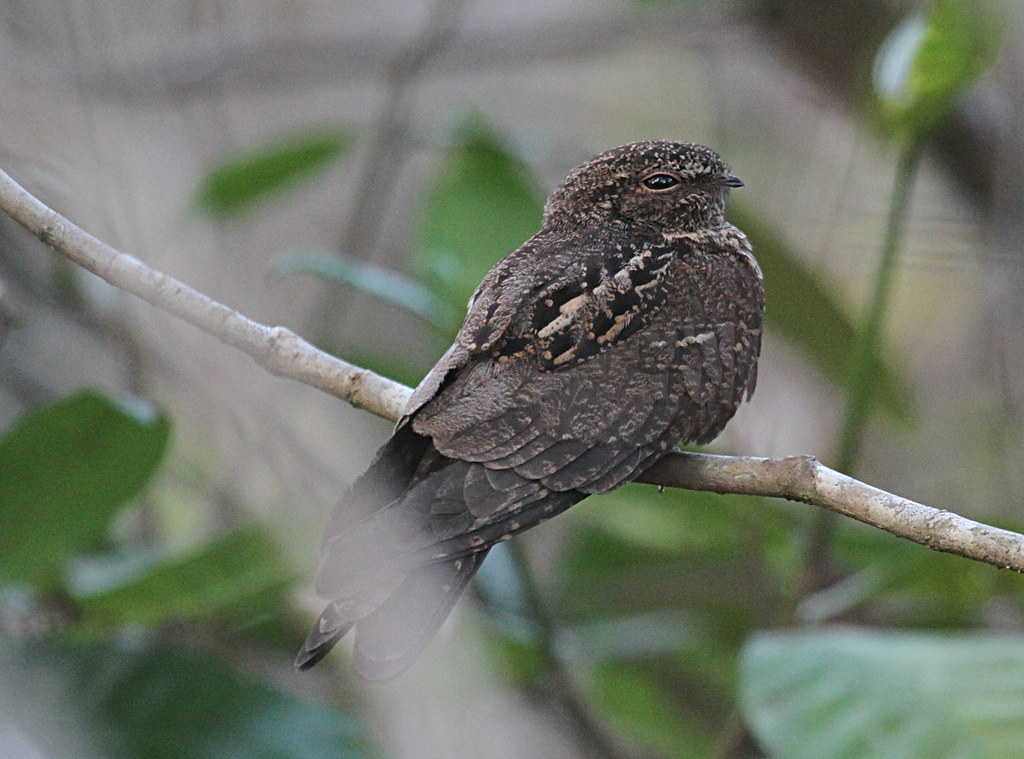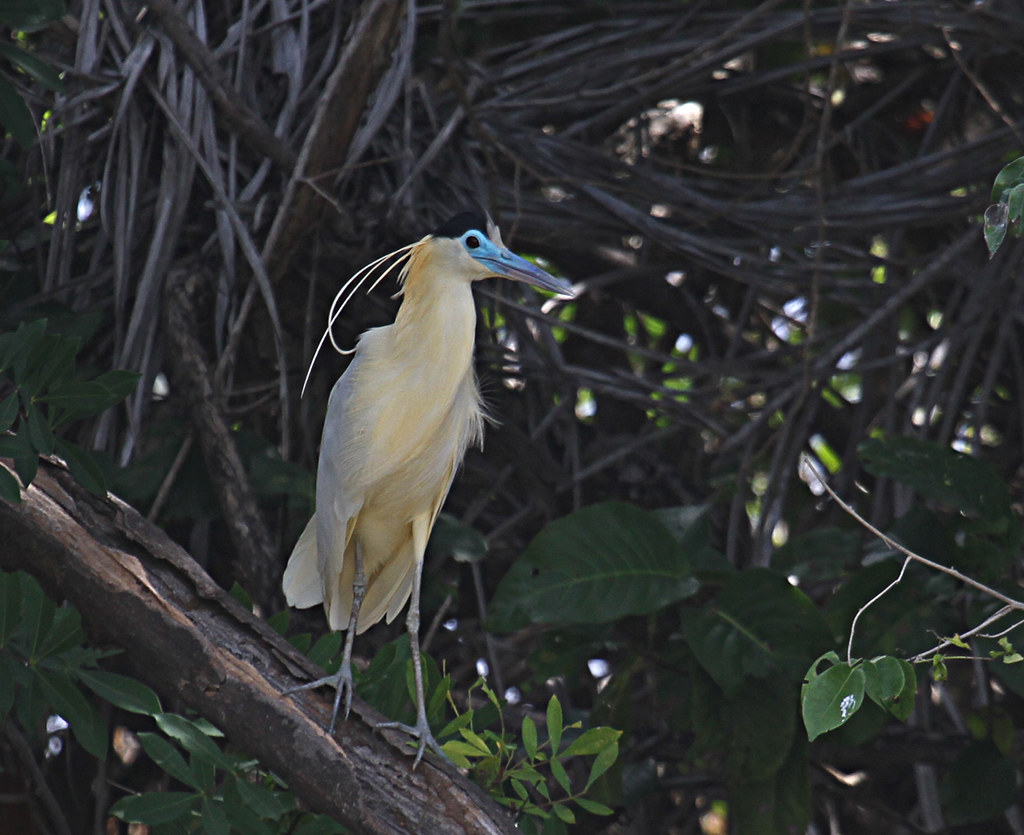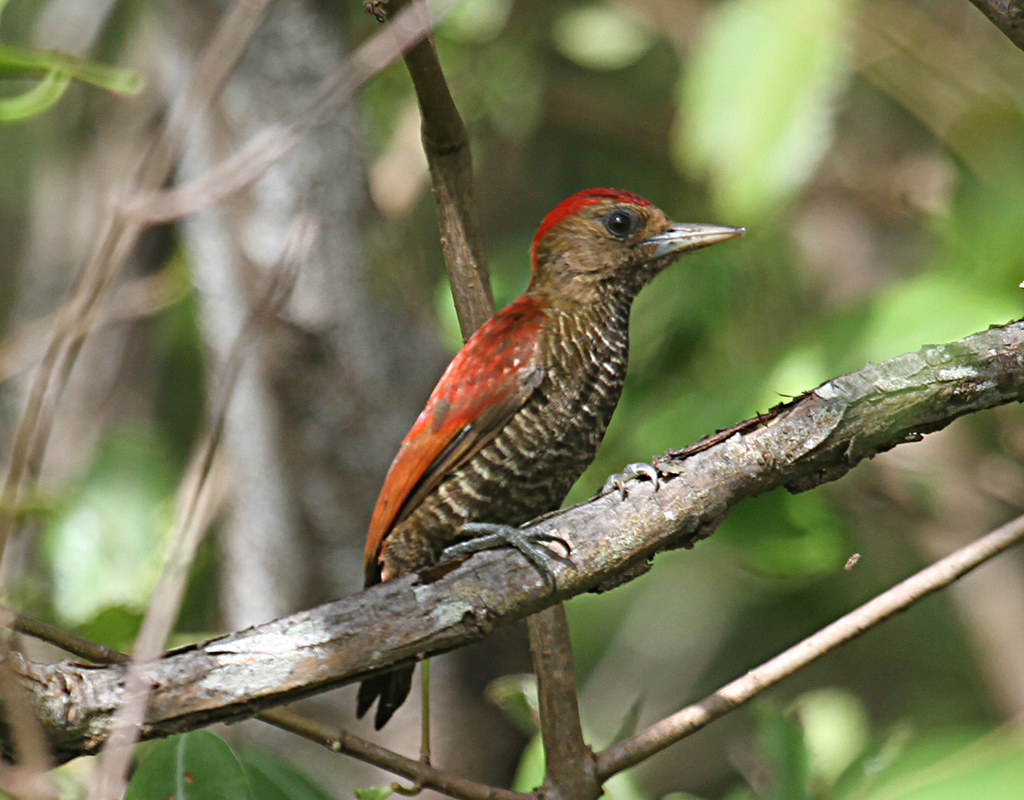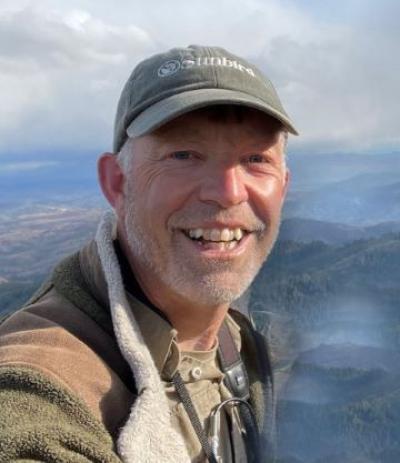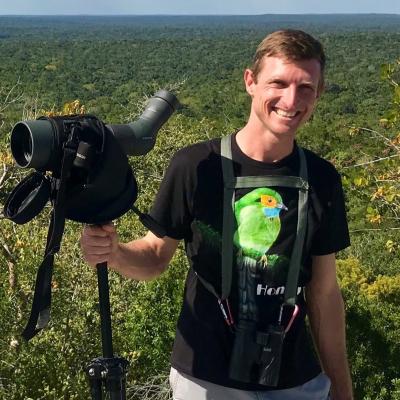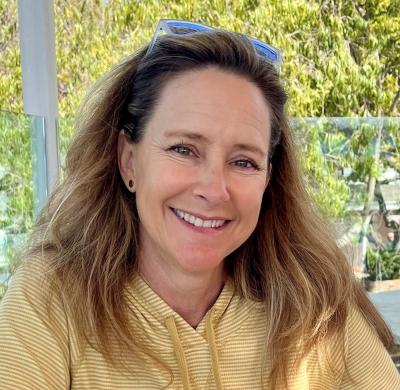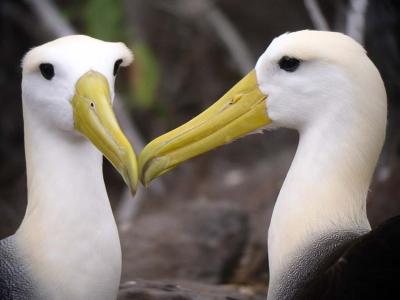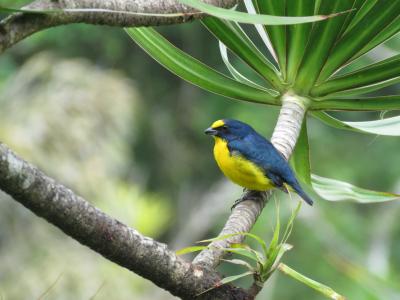Guyana
Kaieteur Falls, Sun Parakeet and Red Siskin Specialties
-
Oct 27 to Nov 9 2024
Rich Hoyer and Roland Rumm
-
Oct 21 to Nov 3 2025
Roland Rumm
2025 Tour Price to be Determined
2025 Tour Price to be Determined
Guyana is a neglected jewel of Neotropical birding. Long overshadowed by its better-known neighbors to the west and south, this English-speaking country on the northeast coast of South America includes vast expanses of unbroken forest among its wide range of habitats. A wide diversity of parrots, cotingas, and antbirds will likely keep us occupied, as will a long list of other specialties such as Blood-colored Woodpecker, Rufous Crab Hawk, and even Sun Parakeet and Red Siskin! The country’s impressive system of rivers makes for easy travel by boat to many of the prime birding areas. This tour to one of South America’s better-kept secrets is a fine introduction to the continent’s birds and an opportunity to experience the region’s many endemics (some of them recently split).
The Guyanese government is working closely with indigenous peoples to create a sustainable ecotourism economy in the country’s interior, and our use of indigenous guides and lodges in local communities on this tour contributes directly to that effort, an experiment in conservation on the grandest possible scale.
Day 1: The tour begins at 6:30 p.m. with a meeting in the lobby of our hotel in Georgetown, Guyana. Night in Georgetown.
Day 2: We’ll depart before dawn, heading east along the coast to the Mahaica River. We’ll spend a couple hours birding from a small boat along the river, looking in particular for Guyana’s national bird, the Hoatzin. In addition to Hoatzin, we’ll enjoy a number of other riverside birds, perhaps including Green-tailed Jacamar, Long-winged Harrier, Silvered Antbird, Black-capped Donacobius, Little Cuckoo, and Yellow Oriole. We’ll also have our first chance to search for a few regional specialties, including White-bellied Piculet and Blood-colored Woodpecker. After breakfast at our boat captain’s house, we’ll continue on birding the nearby rice fields and patches of mangroves, looking for various waterbirds and perhaps even the local Rufous Crab Hawk. After an almost full morning here we’ll backtrack toward Georgetown, with at least one stop to check the mangrove-lined coastal mudflats. Our chief target here among the throngs of waders and passing seabirds is the aptly named Scarlet Ibis. The intensity of this bird’s red plumage, especially set against a backdrop of Snowy Egrets and Little Blue Herons, should form an indelible memory of color. Additionally, we should encounter numbers of Snail Kites, Limpkins, and Wattled Jacanas, among others.
After lunch at our hotel and a siesta, we’ll spend the remaining few hours of daylight at the Georgetown Botanical Gardens. This urban park is home to quite an impressive variety of birds, including several species of parrot (Festive, Orange-winged, Yellow-crowned), Red-shouldered Macaw, Blood-colored Woodpecker, White-bellied Piculet, Gray Kingbird, Violaceous Euphonia, Wing-barred Seedeater, and much more. Night in Georgetown.
Day 3: After breakfast, we’ll transfer to the nearby airport at Ogle for our charter flight to the interior. We’ll fly past the Demerara and Potaro Rivers and over hundreds of miles of unbroken tropical rainforest to land at Kaieteur, the world’s largest single-drop waterfall (by volume) and also spectacularly tall at 741 feet. This amazing waterfall is one of the scenic highlights of the tour; we’ll have ample opportunity to appreciate its grandeur from our plane and from the ground. We’ll have a packed lunch at Kaieteur and explore the trails around the falls, looking for Guianan Cock-of-the-rock in the forest and perhaps even Orange-breasted Falcon or White-tipped Swift cruising around the spectacular cliffs.
We’ll then continue to make the journey toward Iwokrama River Lodge, flying to a small airstrip at Fairview and driving the short distance to our lodge. After some time to settle into our rooms at Iwokrama, we’ll enjoy some evening birding on nearby trails (perhaps including the bizarre Capuchinbird!), before having dinner overlooking the pristine rainforest and river. Night at Iwokrama River Lodge.
Day 4: The Iwokrama Rainforest is a vast wilderness of one million acres, established in 1996 as the Iwokrama International Centre for Rainforest Conservation and Development and located in one of the last four untouched tropical forests of the world, the Guiana Shield of northeastern South America. This is a protected area with a difference: the full involvement of people. Iwokrama is exceptional among conservation organizations because it joins with local people in every aspect of its work, from research to business, ensuring local economic and social benefits from forest use and conservation. On our first morning we’ll bird along the trail to Turtle Mountain. This two-mile-long trail winds up to about 950 feet and, although steep in places, has handrails and steps to make the passage manageable. The open understory of the lower trail makes it easy to watch mixed-species flocks, and here we’ll seek out birds such as Fasciated, Cinereous, Dusky-throated, and Amazonian Antshrikes, Brown-bellied Stipplethroat, Black-chinned and Common Scale-backed Antbirds, Wedge-billed and Buff-throated Woodcreepers, and if we’re very lucky, maybe even Red-and-black Grosbeak or Yellow-billed Jacamar! We’ll spend some time at a small clearing along the trail, looking for Black Nunbirds and Guianan Trogons along the edge. Once the trail starts climbing, the character of the forest rapidly changes. Mixed-species flocks are regular in the canopy along the upper part of the trail, where the shorter trees allow for slightly easier viewing. Here we might encounter birds such as Red-legged, Green, and Purple Honeycreepers or Spotted, Paradise, Bay-headed, and Opal-rumped Tanagers.
In the afternoon we’ll again take a boat down the Essequibo River, where we might see Anhingas, Ospreys, and Green Ibis along the riverbanks, Black-collared Swallows cavorting over the rocks and rapids, and parrots (possibly including Dusky and Red-fan) fly overhead. We might take another walk on a trail or along the road and search for any species we’ve missed so far. Night at Iwokrama River Lodge.
Day 5: We’ll have some time this morning to explore some other trails around Iwokrama before loading up and continuing over to Atta Lodge. Along the way, of course, we’ll keep our eyes open for roadside flocks, perched raptors, and parrots (and perhaps a few cotingas) or whatever else strikes our interest. Possibilities include Marail and Spix’s Guans, Great Black Hawk, Paradise Jacamar, and Pompadour Cotinga. We’ll make a special stop in an area of white sand forest known as the Mori Scrub, where we hope to encounter the local Black Manakin as well as Rufous-crowned Elaenia, Red-shouldered Tanager, Olivaceous Schiffornis, and Bronzy Jacamar.
Arriving at Atta Lodge for lunch, we’ll then have some time to settle into our rooms and keep an eye out for birds around the lodge clearing (rarely including the rare Crimson Fruitcrow). Our afternoon will likely be spent birding along some trails near the lodge. Night at Atta Rainforest Lodge.
Days 6-7: We have two full days to explore the forest around Atta Lodge. The trails are excellent, and we’ll likely spend some time birding right around the lodge clearing. Another major attraction here is the nearby Iwokrama Canopy Walkway. The 500-foot-long walkway has three platforms, the highest of which is about 100 feet above the ground. These could allow us to get great looks at a range of canopy species, many of which are difficult to see well from the forest floor. We’ll probably spend a couple hours birding from the walkway, where the flocks traveling past could include Paradise Jacamar, Guianan Puffbird, Yellow-throated and Waved Woodpeckers, Todd’s and Spot-tailed Antwrens, Black-tailed Tityra, and Dusky Purpletuft, or we can bird along the jungle trails, where antbird flocks can include White-plumed and Rufous-throated Antbirds, White-flanked and Long-winged Antwrens, and Cinereous and Dusky-throated Antshrikes. Roadside birding nearby could provide us with views of parrots such as Red-fan or Blue-cheeked, along with Rose-breasted Chat or Ringed Woodpecker. At least one evening will be spent on the roadside hoping for a glimpse of the rare White-winged Potoo. Nights at Atta Rainforest Lodge.
Day 8: After a brief morning’s outing around Atta, where we could encounter species such as Pied Puffbird, Rose-breasted Chat, and Amazonian Grosbeak, we’ll start our transfer to Surama Ecolodge. On the way, we may stop at one or more trails for some additional birding time before heading to Surama: Gray-winged Trumpeter, Black Spider Monkey, Guianan Cock-of-the-rock, and Ferruginous-backed Antbird are all possible. If there is an active Harpy Eagle nest along our route, we will make an effort to get into the forest to see this incredible bird. We’ll then continue on to Surama Ecolodge for lunch.
On arrival at Surama we’ll receive a welcome from a village councilor and settle into our accommodation. The pleasant community of Surama is set in five square miles of savannah and surrounded by the densely forested Pakaraima foothills. Surama’s inhabitants are mainly from the Macushi tribe and still observe many of the traditional practices of their forebears. Our accommodations will be in benabs (thatched sleeping shelters), and our meals will feature excellent local produce. There is great birding leading to the village and in the surrounding savannah, and we may see Savannah Hawk, Great Potoo, Fork-tailed Palm-swift, and Red-bellied Macaw during the drive to the lodge. For our first afternoon here we’ll likely explore the forest edge and open savannah looking for species such as Black, Crested, and Yellow-headed Caracaras, Scaled Pigeon, Plain-crested and Lesser Elaenias, Cayenne Jay, Green-tailed Jacamar, Ruddy-breasted Seedeater, and Finsch’s Euphonia. As dusk falls, Common Pauraque, White-tailed Nightjar, and Lesser Nighthawks often appear around the lodge grounds. Night at Surama Ecolodge.
Day 9: For our full day at Surama we’ll likely concentrate on the forests around the Burro Burro River. There are several interesting species to be seen here, one of the undoubted specialties of the area being Rufous-winged Ground-Cuckoo. While this species is very tough to find, the nearby forests are certainly among the better places in the Neotropics to look for it –but of course there are no guarantees! Ant swarms are surprisingly regular here and often have attendant antbirds and woodcreepers, including the hard-to-pin-down Rufous-throated Antbird and possibly the even scarcer Red-billed Woodcreeper. More regular possibilities include Great Jacamar, Black-necked and Green Aracaris, Crimson-crested and Red-necked Woodpeckers, Rufous-bellied Antwren, and White-crowned and Golden-headed Manakins. Night at Surama Ecolodge.
Day 10: We’ll have one more full morning of birding at Surama, with an exact plan depending on what birds we haven’t seen yet. After some time to pack up and a nice lunch, we’ll start our transfer to Manari Ranch, which should take around three hours. The transition from the forest to the savannah will be stark: a reminder of how our birding will change, too, for the next several days. We’ll arrive in the heat of the day and have a siesta, followed by some easy birding around the lodge grounds before sunset.
Day 11: Today we’ll watch the sunrise over the savannah as we drive towards the village of Karasabai…with a very special goal in mind! Our primary target today is the stunning Sun Parakeet, a bird so bright and colorful you almost need sunglasses to watch it. If all goes according to plan, we’ll have a picnic breakfast just after dawn while scanning the rolling hills for flocks of parakeets, and depending on our luck, we should have some extra time to search for various other species. Possibilities include Green-tailed Jacamar, White-bellied Piculet, Black-crested Antshrike, Southern White-fringed Antwren, Blue-backed Manakin, Pale-eyed Pygmy-Tyrant, and Burnished-buff Tanager.
This day will require a very early departure (probably around 4:00am) from Manari Ranch; the drive to Karasabai usually takes two to three hours depending on the road conditions. We’ll arrive back at Manari Ranch in the mid-afternoon and will have a couple hours of free time before dinner, in preparation for another very early start the following morning. There will be time for some optional independent birding around the grounds. Night at Manari Ranch.
Day 12: We have another very early start this morning (3:30 am), but don’t worry, we’ll be gently rocked back to sleep (if you so desire) in the back seat of a 4-wheel drive vehicle while riding along dirt roads…this time, heading to the village of Sand Creek to look for the endangered Red Siskin! This stunning bird is highly localized and we’re heading to one of the best places in the world to see it. It might take some patience and effort to find the siskins, but there are plenty of other birds in the surrounding patches of woodland to keep us occupied, including Plain-breasted Ground-Dove, Sooty-capped Hermit, Rusty-winged Antwren, White-bellied Antbird, Amazonian Scrub-Flycatcher, Pale-bellied Tyrant-Manakin, and Plumbeous Seedeater.
After checking in at the village of Sand Creek, where the community has recently taken a keen interest in conversation and ecotourism, we’ll continue our journey to Wichabai Ranch for lunch. Along the way, we’ll be sure to look for open savannah and wetland species like Bearded Tachuri, Pinnated Bittern, and Sharp-tailed Ibis. After a delicious lunch, we’ll work our way back to Manari Ranch in time for dinner. Night at Manari Ranch.
Day 13: Our main birding stop this morning will be at the Ireng River, which holds a few specialties that we won’t see elsewhere on the tour. With any luck, these will include Hoary-throated Spinetail and Rio Branco Antbird. It will be a fairly leisurely day compared to the previous two, with a relaxed lunch at Manari Ranch followed by a transfer to the airport in Lethem for our flight back to Georgetown. After arriving back at the Ogle airport in Georgetown, we’ll transfer to Cara Lodge for our farewell dinner. Night in Georgetown.
Day 14: The tour concludes this morning with a transfer to the airport for international flights home.
Note: The information presented below has been extracted from our formal General Information for this tour. It covers topics we feel potential registrants may wish to consider before booking space. The complete General Information for this tour will be sent to all tour registrants and of course supplemental information, if needed, is available from the WINGS office.
ENTERING AND LEAVING GUYANA: Citizens of the United States, the United Kingdom and Canada do not need visas for visits up to 90 days. Every visitor must, however, have a passport valid for more than six months after your scheduled departure from Guyana and with at least one blank page for entrance and exit stamps.
COUNTRY INFORMATION: You can review the U.S. Department of State Country Specific Travel Information at https://travel.state.gov/content/travel.html.
PACE OF TOUR: This is a moderately strenuous tour, with lots of walking in hot and humid conditions.Our tour will have several long days and regular walks of two or three miles or more on trails that may be uneven and muddy. Participants should be reasonably fit and expect to be on their feet for fairly long periods of time – a folding stool might come in handy.
We’ll make early starts most days so as to be in the field in the coolest part of the day. Please note that we have several VERY early departures on this tour: day 2 (4:30am), day 12 (4:00am), and day 13 (3:30am). These early departures are required to reach the birding areas at the best time of morning. For the rest of the tour, our standard breakfast time is 5:30 or 6:00am.
We try to balance the early starts and consistent walking with a mid-day break of a couple hours during the slower and warmer hours of the day. This can be a good time for a nap, some reading, or catching up on birding notes. We’ll then make an afternoon outing, by foot, boat, or vehicle, before returning to our lodge before dinner and checklist. The tour visits only lowlands, and we remain below 2,000’ elevation for the duration of the tour.
RESTROOM BREAKS: We’ll be birding mostly in remote and undeveloped areas. Thus, “real” bathroom facilities are typically lacking during the hours that we’re away from our lodges. All tour participants should be comfortable taking restroom breaks in nature. Typically we are away from the lodges for the morning and back by lunch. On a few days, we may be out most of the day or have a bit longer between stops.
HEALTH: The Centers for Disease Control and Prevention (CDC) recommends that all travelers be up to date on routine vaccinations. These include measles-mumps-rubella (MMR) vaccine, diphtheria-tetanus-pertussis vaccine, varicella (chickenpox) vaccine, polio vaccine, and your yearly flu shot.
They further recommend that most travelers have protection against Hepatitis A and Typhoid. Please contact your doctor well in advance of your tour’s departure as some medications must be initiated weeks before the period of possible exposure.
Yellow Fever: The Centers for Disease Control recommends yellow fever vaccination for all travelers to Guyana. The Guyanese government requires proof of yellow fever vaccination from all travelers arriving from countries where yellow fever is present.
Malaria: There is a risk of malaria in some parts of the country, and resistance to Chloroquine has been reported.
The most current information about travelers’ health recommendations can be found on the CDC’s Travel Health website at http://wwwnc.cdc.gov/travel/destinations/traveler/none/guyana?s_cid=ncezid-dgmq-travel-single-001
Leishmaniasis: This is a rare but present disease in the areas we visit. The only way to prevent leischmaniasis is to avoid insect bites (in this case sand flies) using long-sleeved shirts, pants, and insect repellent. The probability of getting leischmaniasis during a short trip to Guyana is quite low.
Smoking: Smoking is prohibited in the vehicles or when the group is gathered for meals, checklists, etc. If you are sharing a room with a nonsmoker, please do not smoke in the room. If you smoke in the field, do so well away and downwind from the group. If any location where the group is gathered has a stricter policy than the WINGS policy, that stricter policy will prevail.
Miscellaneous: Biting insects are typically not very numerous, but this depends on recent weather conditions and there can be areas with mosquitos, small sand flies, and biting black flies. Chiggers can be especially troublesome. Note that chiggers especially are difficult to avoid, and are almost inevitable at some point on a tour in Guyana. They seem to be most likely on our first day of birding along the coast, but are possible elsewhere. We recommend tucking pants into socks, or wearing rubber boots, and spraying insect repellent around your ankles and legs. Many people have found that treating clothing with permethrin is particularly useful.
Several species of biting insects act as vectors for parasitic agents in Guyana, and the prevention of bites is the best remedy possible. A can of spray repellent should provide adequate protection against the mosquitoes, sandflies and black flies, while chiggers and ticks can normally be avoided by staying out of the grass on the trails and road. If you are especially sensitive to insect bites, bring an antihistamine.
Tap water is not safe to drink. Bottled water is widely available.
CLIMATE: Guyana’s dry season lasts from October to April. Temperatures in the Guyanese lowlands can reach the 90’s (°F) at mid-day and humidity can be high. Rain can occur at any time, and you should have an umbrella and waterproof footwear with you at all times.
ACCOMMODATION: Our hotel in Georgetown is modern and contains all of the usual amenities of a standard resort hotel. The Iwokrama River Lodge is well appointed (electricity 24H, Wi-Fi, cell phone signal). The facilities at Atta and Surama are more rustic, with basic but comfortable accommodations. Note that at the more remote lodges electricity might not be available 24h after the generators are turned off or when the solar batteries are emptied because of lack of sun or too much use by the guests. Wi-Fi internet access using satellite connections is available at most of the lodges and is usually charged around 5 USD for one hour. Hot showers are only available at our hotel in Georgetown. All the other accommodations used during the trip only have cold water (but it is warm enough not to need hot water!). All of the lodges provide mosquito netting over the beds.
FOOD: Guyanese food is a wonderful mix of Caribbean, Indian and indigenous tastes, with excellently flavored sauces, vegetables and rice and meats. The constant supply of fresh tropical fruits and amply apportioned dinners are a great bonus as well.
Food Allergies: We cannot guarantee that all food allergies can be accommodated at every destination. Participants with significant food allergies or special dietary requirements should bring appropriate foods with them for those times when their needs cannot be met. Announced meal times are always approximate depending on how the day unfolds. Participants who need to eat according to a fixed schedule should bring supplemental food. Please contact the WINGS office if you have any questions.
Drinks: Bottled water or a soft drink or a beer is provided at lunch and dinner, as is coffee or tea. All other drinks or ‘personal’ drinking water for use in your room, etc., are the responsibility of the individual. We also keep bottled water on the coach for “emergency” use during the day. As it can get hot during the day, we recommend that you bring a large, good-quality water bottle and keep it topped off.
TRANSPORTATION: We will employ a variety of transportation methods during this tour, including modern passenger buses, high-speed and small watercraft, small aircraft, 4WD vehicles or pickup trucks. Participants should be able to ride in any seat in our tour vehicles.
LUGGAGE: Baggage weight and cargo limits on internal flights in Guyana are strictly enforced – it’s imperative to keep this in mind when packing. You will be notified of the weight limits with the Tour Confirmation and Final Tour Information details about 2-3 months prior to departure. The combined carryon and checked baggage weight limit on internal flights in Guyana is technically 9.1kg (20lbs), a weight limit that is difficult to meet even for the lightest of travelers. The airline will allow overweight luggage on the aircraft (within the limits of safety), but they will charge an overweight baggage fee of about US$0.98/pound, one way. WINGS will cover overages up to 9.1kg, for a total baggage weight of 18.2kg (40lbs).
PHOTOGRAPHY: Scenery and memory shots will be plentiful and easy to obtain, but birds are very difficult to photograph in tropical rainforests. During our days in the forested areas of Iwokrama, photographing birds will be relatively difficult. However, during our visit to the open habitats in the savannas, along the rivers of the interior and on the canopy tower, there will be better opportunities for photography. Please be aware that birdwatching tours do not provide the best conditions for bird photography, as we frequently cannot remain long enough in one location and the group will move with the leader so may not be able to stay in locations for better lighting or a better view of the bird once everyone has had a chance to see the bird. If you wish to ‘digiscope’ please ensure that you bring your own telescope; the leader’s scope will not be available for this purpose. Be certain to bring as many memory cards as you think you will use, as it may be difficult to find precisely what you need on short notice. Camera equipment should be packed in moisture- and dust-proof bags as a precaution.
2023 Narrative
In Brief
Guyana is one of those special countries that is never monotonous, never disappointing. With a small population and relatively undisturbed habitat, it feels like we’re really birding in the wilderness, and nature can go about its business around us. This tour certainly lived up to expectations, with great surprises alongside the “regular” cast of characters. We began on the coast with spectacular Hoatzin and specialties like Blood-colored Woodpecker and Rufous Crab Hawk, continued into the heart of the Iwokrama forest with Guianan Cock-of-the-rock, Capuchinbird, Pompadour Cotinga, and endless ant-things, and finished in the savannah where our eyes nearly melted from Sun Parakeets and Red Siskins. Back to Georgetown on the final day, with another boat trip that produced a country-first Audouin’s Gull! Wow…Guyana certainly deserves to be at the top of every birder’s must-visit list!
In Summary
Our tour started with an early wake-up and pre-dawn drive east of Georgetown, to the Mahaica River. Here, we were greeted by Long-winged Harriers flying over and Yellow Orioles in the trees, before enjoying a pleasant boat ride with plentiful Hoatzins along with Green-tailed Jacamar, deafeningly-close (but nearly invisible) Silvered Antbirds, and a selection of other common species. The drive back to Georgetown was enlivened by a stop in the mangroves, where Rufous Crab-Hawk and Scarlet Ibis performed brilliantly.
The afternoon at the Georgetown Botanical Gardens was very pleasant and we racked up a nice selection of birds. During our stroll we enjoyed many Gray Kingbirds, a trio of Amazona parrots side-by-side in the canopy (Festive, Yellow-crowned, and Orange-winged Parrots), a super cooperative Cinnamon Attila, Wing-barred Seedeaters, White-bellied Piculet, and a great eye-level Blood-colored Woodpecker. We ended the evening with the regular pair of Great Horned Owls before heading back to the Cara Lodge for dinner.
Our journey continued inland the next day with a chartered flight to Kaieteur, noted as the largest single-drop waterfall in the world *by volume* and spectacularly tall as well, at 741 feet. It’s incredibly impressive, and birding here is a secondary endeavor to the amazing scenery, but we still found time to enjoy a few birds…despite the heat, Rufous-crowned Elaenia performed on cue, and we picked out a couple White-tipped Swifts zipping around the falls. One of my favorites here is the adorable Golden Rocket Frog, hiding in the bromeliads at the edge of the plateau—a stunning little frog, endemic just to the Kaieteur area (a range of less than twenty square kilometers!) On the walk back to the airstrip, we enjoyed amazing views of the otherworldly Guianan Cock-of-the-rock (or Spaghetti-scapulared Flameball?!) before flying on to Iwokrama.
Our time at the comfortable Iwokrama River Lodge was an excellent introduction to forest birding, with a dizzying array of ant-things on the Turtle Mountain Trail and plenty of more conspicuous birds around the lodge clearing and river. A clear highlight was a stunning Spotted Antpitta, which eventually cooperated for fifteen-minute scope views (!!!) and plenty of photos. The resident Capuchinbirds are always incredible; their bizarre chainsaw-like vocalizations were particularly memorable. Large-billed and Yellow-billed Terns and a Capped Heron were seen along the river, Painted Parakeets and Orange-winged Parrots plus Channel-billed and White-throated Toucans posed at the edge of the clearing, and we picked through understory flocks with antshrikes (Fasciated, Dusky-throated, and Cinereous), antwrens (Brown-bellied, White-flanked, and Gray), and woodcreepers (Wedge-billed, Chestnut-rumped, and Buff-throated). And I can’t forget the most spectacular views of Ferruginous-backed Antbird strutting around just a few meters away!
On to Atta for three nights, perhaps my favorite spot on the entire tour. The lodge is situated in a small clearing within the forest, and birding the nearby trails and roadside is excellent. Highlights are too numerous to list: the male Rose-breasted Chat followed by a begging youngster was much appreciated; the antswarm with White-plumed and Rufous-throated Antbirds (plus Amazonian Barred Woodcreeper and Rufous-bellied Antwren) wasn’t too shabby either. And what about the unexpected Red-billed Pied-Tanager?! And a male Purple-breasted Cotinga perched along the road! And the Crimson Topaz! Plus Guianan and Pied Puffbirds, Great and Paradise Jacamars, Cream-colored and Waved Woodpeckers, White-winged and Long-tailed Potoo, Black-banded Owl…the list goes on and on. It was an action-packed few days, and we really rounded out our experience with so many great forest birds.
All too soon, it was time to bid farewell to Atta and its excellent birds, food, and staff, and head on towards Surama. Along the way, we stopped at a short trail to a Guianan Cock-of-the-rock lek, which held a few lazy males that eventually gave us a few peeks…but even a peek at this crazy species is better than nothing! And even more exciting was a pair of Wing-banded Antbirds along the trail…a great listen and some quick views added some adrenaline to our day.
Surama was our first taste of savannah birding, with a whole different suite of species to look for. We took a long walk on our first afternoon, with Fork-tailed Palm-Swifts overhead, White-tailed and Green-tailed Goldenthroats feeding in the flowering meadows, and Black-necked Aracaris bopping through the short trees. We ended up at a patch of seasonally flooded forest, where a Great Potoo on its day roost was enjoyed by all. The next morning, a long walk to the Burro-Burro River and back was quite productive in the forest and savannah, with excellent great views of Ferruginous-backed Antbird, White-crowned and Golden-headed Manakins, Wedge-tailed Grass-Finch, and Grassland Sparrow. The highlight of the day for some was a tantalizing and frustrating experience with Rufous-winged Ground-Cuckoo. We bushwhacked into the forest and slowly approached a singing individual, but it refused to reveal itself. It was a fun little adventure and just hearing the song coming from so close in the thickets was exhilarating!
We then continued deeper into the Rupununi savannah, heading to our base at Manari Ranch for the next few nights. Some local intel paid off bigtime along the way; a quick stop at a pond near Surama village produced a Zigzag Heron! A scarce and difficult-to-see Amazonian species, and even more difficult to see during the daytime…so our prolonged scope views were extra special.
Upon arrival at Manari, we took advantage of our first afternoon and headed straight for the banks of the Ireng River, where two extremely range-restricted species are found in the dense thickets: Hoary-throated Spinetail and Rio Branco Antbird. Some patience was necessary, but eventually both surrendered for excellent views…easier than ever! Phew. We made a quick stop on the way back for Least Nighthawks (and another quick stop when the lead vehicle got stuck in some mud…), eventually making it back to Manari for a good night of sleep before our next early morning…
The last few days of our tour were quite a whirlwind, with lots of driving to see a few key birds. We left early from Manari Ranch and headed north to the village of Karasabai, which is famous for its population of Sun Parakeet. This stunning bird has a global population of only a couple thousand, and this is one of the last accessible strongholds. Thankfully, with the help of our awesome local team (Jeremy and Asaf), it didn’t take too long before we were soaking in a flock of these gorgeous birds. Views in the scope were simply amazing, feeding and perched in the open atop various flowering trees. I don’t even like parrots very much, but Sun Parakeet is truly an exceptional bird…the colors are so bright, you almost need sunglasses! The rest of the day was spent picking up a few more savannah birds until we eventually ended up in Brazil for a lakeside lunch…complete with many Capybara among the Muscovy Ducks and Wattled Jacanas.
The next morning also started super early, and we were off on the bumpy dirt tracks to the village of Sand Creek for another very special bird…Red Siskin! Upon arrival, we enjoyed a nice picnic breakfast and scanned the hillsides for siskins. It took some patience, and eventually a flock came into the top of a bare tree…woohoo! We excitedly rushed over and enjoyed prolonged views of male and female siskins, plus a supporting cast of Burnished-buff Tanager, Southern White-fringed Antwren, Lesser Elaenia, Finsch’s Euphonia, and Hepatic Tanager. Awesome!
Our drive back included a brief stop in the town of Sand Creek, where we met with a few ranking villagers, town sheriff and deputy, who along with the villagers are working on conservation efforts for the Red Siskin. They were excited and heartily welcomed our group!
We then had the rest of the day to check out the sprawling savannah and scrub, where highlights included Rufous-winged Antwren, White-bellied Antbird, Amazonian Scrub-Flycatcher, White-naped Xenopsaris, and even a Sharp-tailed Ibis at a little pond. We arrived at Wichabai Ranch for lunch and some downtime: perhaps the best meal of the trip, with incredible hosts Erin and Justin. A little bonus this time was an adorable rescued Capybara named Hydra; she strutted right up to us and appreciated lots of belly scratches! We topped off the day with amazing views of Bearded Tachuri before heading back towards Lethem. It was an exhausting day but very productive!
All too soon, we were ready to fly back to Georgetown and the Cara Lodge…but our fun wasn’t over yet. First, with just an hour of casual birding time before leaving Manari Ranch, Lisa (the ranch owner) informed us that one of the staff members had found a Giant Anteater! We raced down the road and quickly spotted this incredible beast trotting towards us. Wow. We had been hoping to see one for the last several days, and to see this in the nick of time was lucky indeed.
Because our flight to Georgetown was much earlier than normal, we arranged a boat trip on the Demerara River in the afternoon. Everything seemed as-expected at first, with nice birds like Rufous Crab-Hawk and Scarlet Ibis at the edge of the mangroves. Then all hell broke loose when Steve spotted a funny looking gull…which vanished for a few minutes…eventually reappearing atop a wooden post in the river. As the boat maneuvered into better light, we could see the red bill, grayish-olive legs…and it clicked that we were looking at an adult Audouin’s Gull! Wow…a first for Guyana, and perhaps the same individual that was first seen in Trinidad a few years ago?!
As if that weren’t enough, we then headed over to a massive waterbird roost, and enjoyed thousands of incoming waders (Cattle and Snowy Egrets, Little Blue and Tricolored Heron, Scarlet Ibis) as the sun set and torrential rains came in. What a spectacular way to end the tour! Guyana never fails to disappoint with its beautiful habitat, special birds, excellent local guides and lodge staff, and tasty food. Thank you all for such a fun and memorable tour, full of incredible birds and mammals. I look forward to traveling with all of you again!
Luke Seitz
To say that Fabrice was excellent as a guide is not high enough praise. He is so knowledgeable and adept as a guide, so at home in the wild, broadly and deeply attuned to every environment he's in, and companionable and fun to boot!
- Don and Betsy A. on Guyana
Fabrice Schmitt is the best tour leader I've birded with. On top of superb identification skills, he's great with clients. He'd tell us what bird he's trying to call or find, describe it, tell us where it may appear and then position us to maximize our chances of seeing it. Once it's close he's a master at using the laser pointer to ensure everyone sees the target bird. Once seen he's likely to delve into the natural history of the bird and/or its habitat.
- James W. on Guyana
Maximum group size 8 with one leader
































